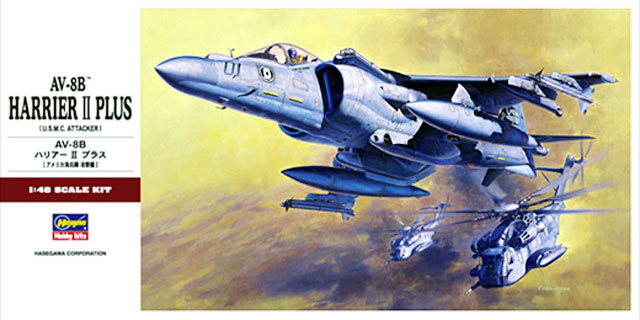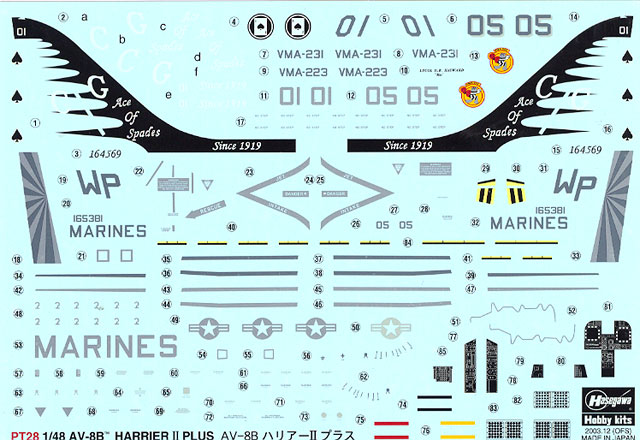|
AV-8B Harrier II Plus
1/48 Scale

Hasegawa
S
u m m a r y
|
| Catalogue Number: |
07228 |
| Scale: |
1/48 |
| Contents and Media: |
156 parts in grey injection moulded
styrene; 10 parts in clear injection moulded styrene; 4 polythene caps; markings for
two
aircraft |
| Price: |
¥2800 |
| Review Type: |
FirstLook |
| Advantages: |
It's a new Harrier in 1/48 scale!
Consistent, fine engraved panel detail; separate blow-in doors; optional
gun pods or lateral strakes; positionable nozzles; separate speed brake;
parts breakdown suggests more variants to be released later; good
selection of stores; interesting decal sheet (including decal for
explosive canopy cord) |
| Disadvantages: |
Barely adequate cockpit detail;
prominent seams on canopy parts; relatively complex fuselage breakdown to
permit multiple variants; parts scuffed due to packing in single bag |
| Recommendation: |
Recommended. |
Reviewed by Brett Green

Hasegawa's 1/48 scale AV-8B Harrier II Plus
will be available online from
Squadron.com
Hasegawa continues its commitment to 1/48 scale jets with their
brand-new 1/48 scale AV-8B Harrier II Plus.
It has been a long time since we have seen a new Harrier in 1/48
scale. Monogram's AV-8B is still a respectable model, but fans of the latest
versions of the Harrier will be delighted to see this kit hit the streets.
Hasegawa's AV-8B Harrier II Plus comprises 156 grey injection
moulded parts, with 10 additional parts in clear plastic. The grey styrene parts
are presented in Hasegawa's typical shiny and slightly brittle plastic. Some of
the larger parts in my kit have already been severely scuffed due to Hasegawa's
habit of stuffing all the sprues into one plastic bag. Some sanding and
polishing will be required prior to assembly.
Surface detail is by way of fine engraved panel lines. All the
panel lines are fully formed and consistent.
Hasegawa seems to have planned this model to ensure a minimum of
ejector pin marks. Indeed, the only imperfections I could find were some tiny
ejector pin marks on one side of the Sidewinder bodies.
Click the thumbnails below to view
larger images:
Kit detail is generally very good. Blow-in doors are supplied as
separate parts, so they can be positioned either open or closed. The nozzles are
connected via internal axles (using the ever-present poly caps), and may be
swivelled into different positions on the completed model. The nozzles
themselves are cleverly designed with the splitter plates moulded onto one
interior half. A good selection of stores and options is supplied, including a
pair of AIM-9L Sidewinders, 300 Gallon drop tanks, gun pods (or optional lateral
strakes if these are not fitted) and an AN/AAQ-28 Litening II Pod. The
all-flying horizontal stabilizers are each mounted via a single stout pin, so
these parts may be positioned neutral, up or dropped.
The speed brake is moulded as a separate part that should be
posed open when the Harrier is on the ground.
One area of disappointment is the cockpit, which is really not
up to the standard of the rest of the kit. Side console, instrument panel and
rudder detail is half-hearted at best. I expect it will not take the
after-market too long to deliver a busier-looking resin replacement.
The clear parts are well shaped but suffer from a seam line
along the entire centreline. This is an inevitable by-product of accurately
moulding the bulged canopy and windscreen. Some careful scraping and polishing
should rectify this problem. A nice touch is the inclusion of a pair of decals
for the explosive cord in the top of the canopy.
Hasegawa's kit has obviously been engineered to permit the later
release of virtually any current Harrier, including British and two-seater
versions. This is great news, but it means that the fuselage in particular is
quite a complex assembly. The nose is made up from two halves; followed by
another pair of separate parts for the cockpit area; then the main fuselage with
a left and right half but also requiring a separate belly part. The fin and
fuselage strake adds another four parts. So that is a total of eleven parts just
for the basic fuselage shape, not including the intakes and blow-in doors.
Considering Hasegawa's erratic reputation for fit, extreme care should be taken
when aligning and assembling these parts.
The wing is much simpler than the fuselage, but it is pleasing
to see that the 100% LERX is separate, suggesting that a 70% LERX may be coming
(Harrier GR.5 or early GR.7 perhaps).
Bumps, lumps, antennae, scoops and chaff/flare are all supplied
as individual parts, reinforcing the likelihood of other variants from Hasegawa
in the future.

Decals are supplied for two interesting aircraft. My samples
were in good register.
I am uncertain about the accuracy of the colour callouts
(36230/36375/35237), which may not represent the current AV-8B Harrier II Plus
greys. I am sure that this issue will be clarified on HyperScale's Plane Talking
group in the coming days.
Hasegawa has cooked up their new 1/48 scale AV-8B Harrier II
Plus using their tried and true, 25 year-old 1/48 scale jet model recipe. The
Harrier is certainly a welcome addition to the range.
Hasegawa does seem to have heeded earlier comments about ejector
pin marks and vague panel lines, as these aspects are much improved with this
release. The stores options are great too. It would be nice to have seen a
better detailed cockpit, but you can't have everything.
Judging from the breakdown of parts in this release, it looks
like we might be seeing the whole modern Harrier family in 1/48 scale at some
time in the future.
Now that is a family reunion I would like to attend!
Recommended.
Text and Images Copyright © 2004 by
Brett Green
Page Created 09 January, 2004
Last updated 12 August, 2004
Back to HyperScale Main Page
|
Home | What's
New | Features
| Gallery |
Reviews | Reference
| Forum
| Search